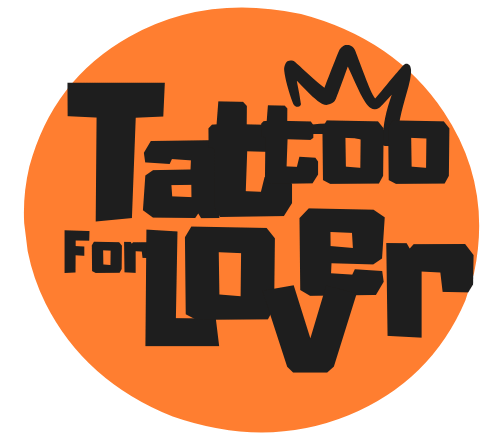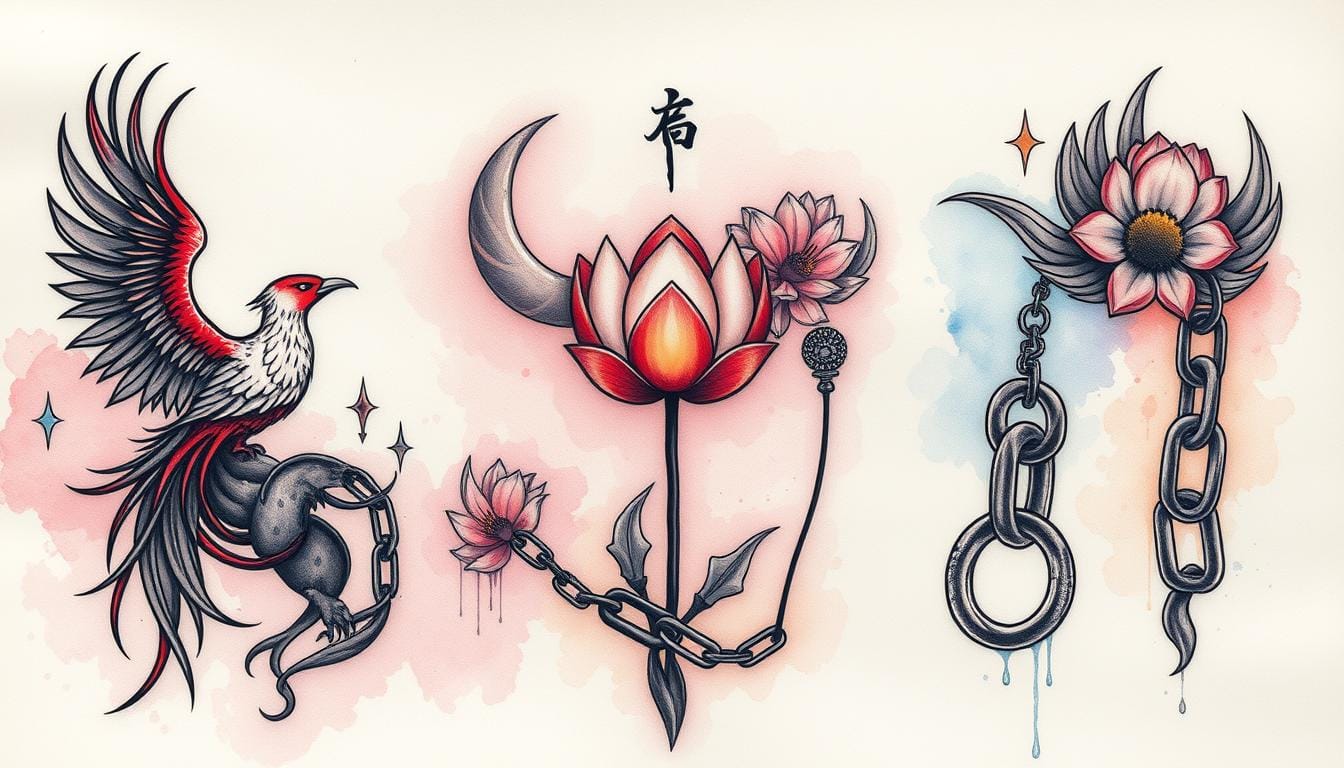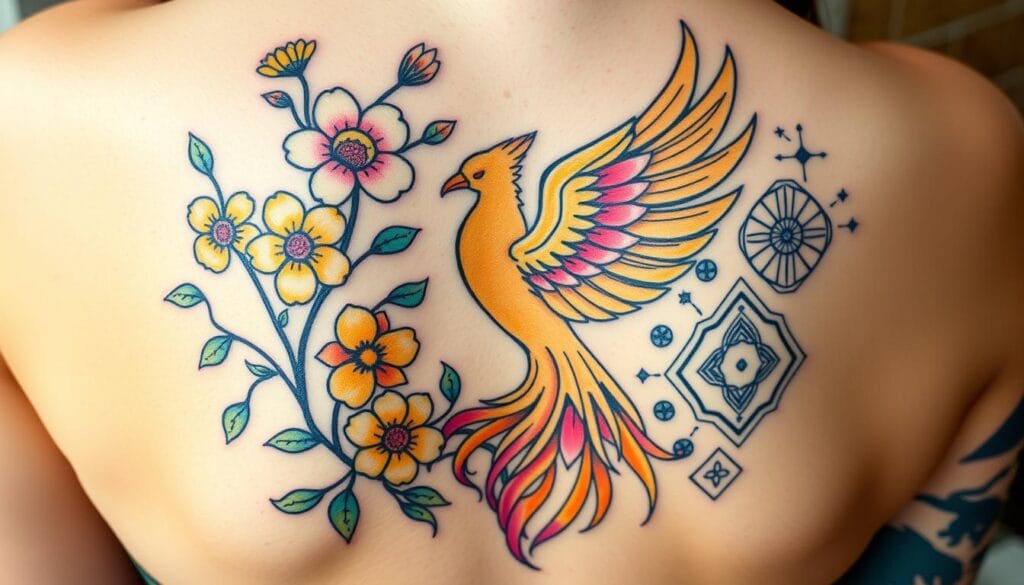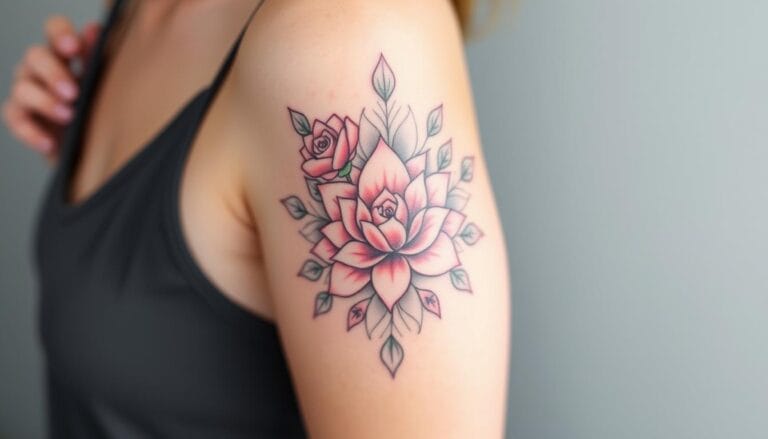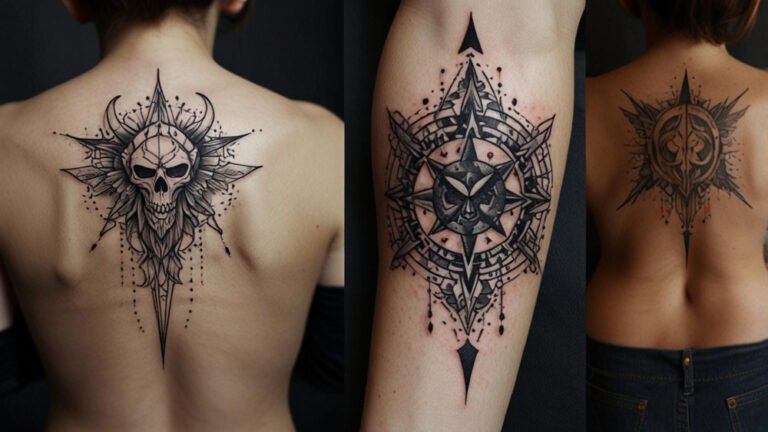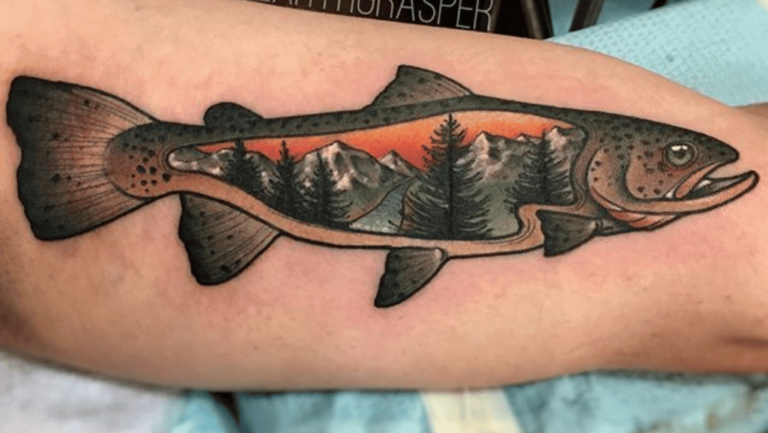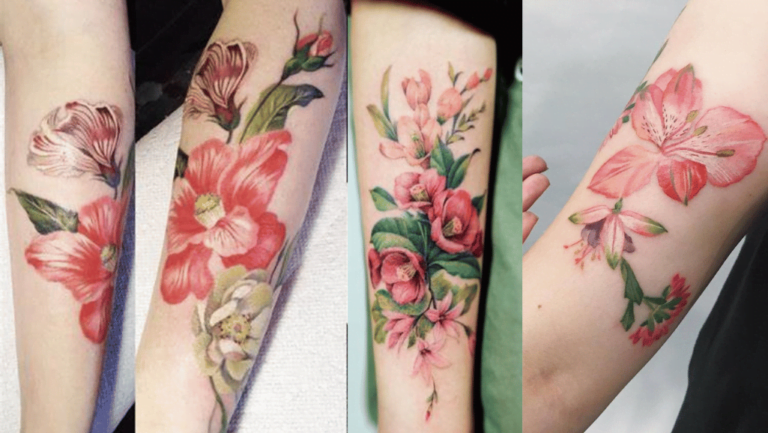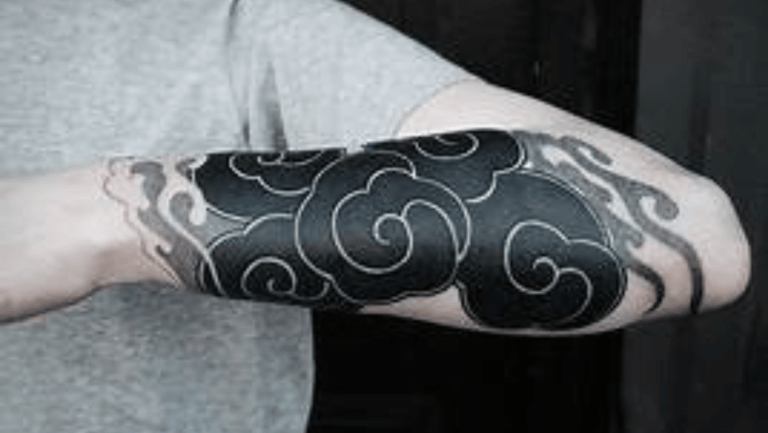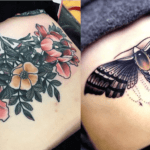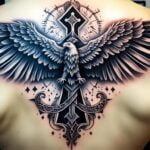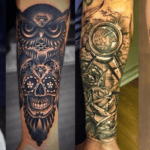The self injury tattoo is a powerful symbol of change. It shows the journey of overcoming struggles. These tattoos tell stories of survival and healing.
They are more than just designs. They are signs of strength and healing. They help people move from darkness to light, embracing self-care.
Each recovery tattoo is unique, showing a person’s fight against self-harm. They mix pain and victory, becoming a reminder of strength. These tattoos are a daily self-care tattoo, showing a person’s will to keep going.
For some, these tattoos are more than just ink. They turn scars into symbols of power and recovery. They change the story of pain into one of strength and ongoing healing.
Key Takeaways
- Self injury tattoos mark a poignant chapter in the healing narratives of many, with 23 out of 30 individuals signifying recovery through their tattoos.
- Musical themes, specifically song lyrics, surface as a source of inspiration for a significant number of people, signaling the power of artistry in healing.
- The semicolon emerges as a prominent symbol, with 13 individuals embedding it into their tattoos as a metaphor for resilience and a refusal to be silenced by self-harm.
- For seven individuals, avian imagery symbolizes the significant support of loved ones in their recovery journey.
- Tattoos signify not just personal transformation but sometimes include nods to broader mental health movements, offering a sense of solidarity.
- The visible shift from self-harm scars to tattoos can be a deeply empowering act of reclamation and self-love.
- Finally, tattoos stand as a daily reminder for six individuals of their ongoing commitment to battle mental health challenges—one day at a time.
Exploring the Significance of Self Injury Tattoos
Tattoos have grown from simple decorations to powerful tools for healing and self-expression. Self-injury scar cover-up tattoos and self harm awareness tattoos are more than just designs. They tell stories of personal struggles and victories. These tattoos symbolize empowerment, healing, and resilience.
Reclaiming Control Through Body Art
Many start their healing journey by taking back control of their stories. Empowerment tattoos are strong statements of taking back one’s life and body. They turn scars into art, showing survival and bravery.
These tattoos are especially meaningful for those who have self-harmed. They turn a painful mark into a symbol of victory and reclaiming one’s body.
The Transformative Power of Self Injury Tattoo Designs
Visual expressions through trauma recovery tattoos and emotional healing tattoos are key in healing. These designs often use symbols that mean a lot to the person or are recognized worldwide. Symbols like semicolons or phoenixes remind of strength and ongoing recovery.
Stories of Resilience: Personal Narratives of Tattoo Recipients
Every tattoo has a story, especially those from past traumas. People with self injury awareness tattoos say these tattoos are both a nod to their past and a sign of hope for the future. Each design tells a story of struggle and triumph, inspiring and supporting others.
These stories fight against stigmas of self-harm and mental health. They help people understand survival and recovery better.
Looking deeper, these tattoos are more than just body art. They are essential tools for self-acceptance and recovery. Tattoos about overcoming self-injury show the human spirit’s ability to heal and thrive. They improve both physical and emotional health, reminding of past struggles and future possibilities.
The Therapeutic Journey: Tattoos as Coping Mechanisms
Today, people are finding new ways to express themselves and heal. Tattoos have become a key part of this, serving as a coping mechanism and a way to express oneself. They are seen as more than just art; they are a tool for mental wellness.
For many, a self care tattoo is more than just a pretty design. It’s a symbol of overcoming challenges and staying strong. This use of tattoos as a therapeutic tattoo helps those who have faced trauma. It offers a unique way to cope, similar to acupuncture.
| Statistic | Details |
|---|---|
| Prevalence of Tattoos in U.S. Adults (2019) | Three out of 10 individuals over 18 |
| Tattoo Trend Increase Post-Pandemic | Rise in tattoos as coping mechanisms |
| Gender Research (18-36 age group) | 398 women and 208 men studied; links with maternal separation and physical appearance anxiety |
| Alternative Healing Research | 30 peer-reviewed articles analyzed including data on indigenous practices and MDMA, psilocybin, EMDR |
| Therapeutic Pain Association | Similarities drawn between tattoo pain and controlled BDSM pain |
| Effect on Self-Harm Practices | Reports of individuals ceasing self-harm post-tattoo experience |
Tattoos are becoming a part of everyday wellness routines. Tattoo artists have seen more people getting tattoos as a form of self-care, especially during the pandemic. With more people working from home, there’s less stigma around visible tattoos, making it easier to explore this form of body art therapy.
Mental wellness tattoos are becoming a big part of modern healing. They show a shift towards accepting new ways of therapy. These tattoos not only decorate the body but also enrich the soul, marking personal growth and recovery. They show how art and healing can come together, offering powerful messages of resilience and self-healing.
Self Injury Tattoo as a Form of Empowerment and Body Positivity
Self injury tattoos play a big role in personal expression and healing. They change from symbols of pain to signs of strength. These tattoos stand for body positivity tattoo and self love tattoo. They help people cope with self harm and celebrate their survival.
Studies show tattoos are a mature choice for self-expression. Most people get tattoos between 30 and 39 years old. Women have led the way since the 1960s, using tattoos to show their independence and self-image.
Fostering Self-Acceptance and Love
Self love tattoos help people accept themselves. These tattoos often have symbols or quotes that mean a lot to the person. They range from simple words to detailed designs that show personal growth.
Each tattoo tells a part of the person’s story. It celebrates their uniqueness and boosts their self-esteem. Tattoos remind people of their worth and strength, helping them love themselves more.
Supporting Mental Health with Positive Tattoo Designs
Empowerment tattoos do more than look good; they help with mental health. A study found that people with tattoos have lower stress levels. This shows tattoos can be therapeutic.
Psychologists and reports show tattoos are used in therapy. They help people avoid self-harm and deal with trauma. Tattoos are more than decorations; they help with anxiety, depression, and PTSD.
Tattoos also bring people together. They share stories of overcoming challenges. This shows the power of body positivity tattoos in building community and self-acceptance.
| Benefit | Description | Demographics Most Affected |
|---|---|---|
| Self-Esteem Boosting | Provides individuals with a tangible affirmation of their self-worth and progress. | Women, particularly those aged 30-39 |
| Mental Health Support | Acts as a therapeutic medium to reduce stress and manage symptoms of mental disorders. | Gen Z and Millennials with high prevalence of mental health issues |
| Community Building | Encourages a sense of belonging by connecting individuals through shared experiences. | Individuals coping with trauma or seeking recovery community |
In conclusion, self injury tattoos have changed a lot. They help people take back their story and find healing through ink. These tattoos are more than just decorations; they are key to acceptance and empowerment.
Cultural Shift from Stigma to Acceptance
The story of acceptance tattoo art has changed a lot. It’s now seen as a way to show personal growth, not just a taboo. This change is part of a bigger shift in how we view cultural acceptance of self injury tattoos.
What was once seen as non-suicidal self-injury (NSSI) is now a powerful way to share deep feelings and stories. This shows how tattoos can change and grow with us.
Mental health tattoos are like body stories. They help people deal with their feelings and change how others see them. These tattoos fight stigma by turning scars into messages of hope and recovery.
| Age Group | Percentage with NSSI History | Negative Cognition About NSSI Scars | Implicit Bias against NSSI (IAT results) |
|---|---|---|---|
| Adolescents | 17.2% | High | Strong negative bias |
| Young Adults | 13.4% | Moderate | Moderate negative bias |
| Adults | 5.5% | Lower | Lower negative bias |
For more on this change, check out an article on tattoos as self-expression. It talks about how tattoos have moved from rebellion to symbols of strength and healing.
Anchor tattoos, for example, mean more than just being about the sea. They stand for stability and hope. These tattoos are popular among those who have faced tough times, showing how tattoos help in healing and telling our stories.
The growing acceptance of tattoos, especially those about self-injury, shows a big cultural shift. It’s a sign of respect for personal stories of pain, struggle, and recovery. This acceptance helps us understand each other better and builds a healthier view of body art and personal history.
Conclusion
Tattoos and personal growth are closely linked. More people are using healing through tattoos to overcome self-harm issues. Tattoos are becoming symbols of personal journeys and strength.
Studies show tattoos are common in today’s culture. They help people express themselves and cope with mental health issues. This is seen at tattoo conventions and university campuses.
Research has found interesting links between tattoos and mental health. It shows tattoos can be a way to express oneself, especially for those with anxiety, depression, or low self-esteem. Tattoos have a long history, dating back to ancient times.
In the world of positive tattoo design, a compass tattoo is a powerful symbol. It represents stability and balance, which are key in recovery. Tattoos are now seen as stories of survival and identity.
They help people accept themselves and others. Tattoos are a way to share and understand each other’s struggles. This is a key part of our conversation on mental health and self-injury today.
FAQ
What is a self injury tattoo?
How do self injury tattoos help in the healing process?
Can getting a tattoo actually be a form of therapy?
What are some common designs for self injury tattoos?
What should I consider before getting a self injury tattoo?
How can a self injury tattoo promote body positivity?
Are self injury tattoos accepted in society?
Is it possible to use self injury tattoos in mental health advocacy?
What should I do if I want a tattoo to cover self harm scars?
Can a tattoo actually help in preventing self-harm?
Forhad
Forhad's writing is not just about the artistry of tattoos or the latest trends in the industry; it's an exploration of the deep-rooted connections people have with their tattoos, reflecting personal narratives, cultural histories, and moments of transformation. Through a mix of in-depth features, personal narratives, and insightful analyses, he sheds light on the multifaceted nature of tattooing, revealing the emotional and cultural layers that lie beneath the surface.

